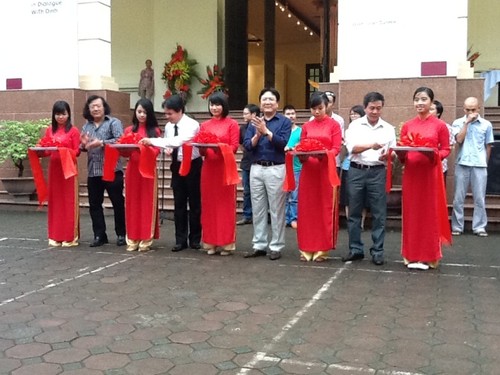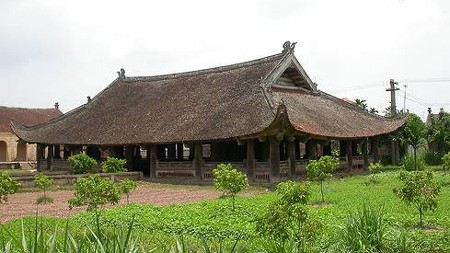(VOVworld) – For generations, the communal house has been a center for preserving and promoting the traditional values, customs, and habits of the Vietnamese village. The recent exhibition “Communal house dialogue” reflects artists’ view of what the communal house means to rural people’s lives.
 |
| The inaugural ceremony of the exhibition |
The exhibition, which creatively combined the contemporary art genres of installation, video, sound and photography, reminded visitors of the cultural values of the communal house. Painter Dang Thi Khue said the exhibition provided an opportunity for artists to approach social heritage: “The communal house is different from other heritage items. It’s a living heritage because it exists with the people over time. I share other artists’ concern about the current state of relics and the people’s attitude towards them. Heritage means assets inherited by contemporary people”.
Entering the pavilion, one sees paddy rice drying in the communal house’ yard and kites flying high in the sky. Vu Dinh Tuan wrote short proverbs and sayings on soft cloth bands. Nguyen The Son told the story of the current state of communal houses in Hanoi through a photo collection. Some houses have been turned into shops, cafés and banks. Visitor Nguyen Van Hoc said: “The communal house in the city is different from other places. Unlike rural areas, communal house in Hanoi is tall with curved roofs, matching urban life. The point here is how we treat them during urbanization”.
 |
| Dinh Bang communal house in Bac Ninh |
Artist Nguyen Ngoc Lam created a cramped urban space with tube-shaped neatly-built houses which block a gold-painted communal house. Dang Thi Khue’s lively installation features a pair of big cranes, fallen leaves in the front yard of a 17th century communal house, shoes and sandals at the house’s threshold: “I know the communal house contains architectural and aesthetic values and multiple functions. The more I learn, the more puzzled I feel about these values, which might take generations to understand. I create an environment almost like a living museum or a garden to influence the public. I intend to focus on a horizontal section of the communal house so that visitors can explore its internal parts.”
In his video art, Le Chi Hieu displayed an image of 100 eggs, representing the nation’s origin and values, which have already been generated and will linger on. Each egg is a life, a story, and a heritage piece that needs to be preserved.
Musician Vu Ngoc Tan brought unique nuances to the “dialogue” by mixing the sounds of modern daily life and folk music. Nguyen Huu Duc, a lecturer at the College of Fine-Arts, told VOV: “Each person interprets the sound in his own way. This is the sound of life, which surrounds the communal house. Traditionally, the communal house is separated from residential areas, but it’s different now”.
The exhibition “Communal house dialogue” is part of a project to study, collect, and promote special values of communal house culture in Vietnam’s northern delta carried out by the College of Fine Arts.